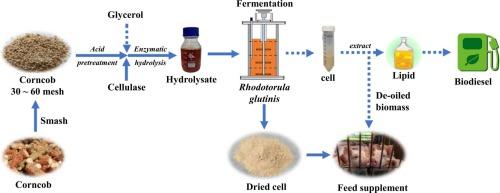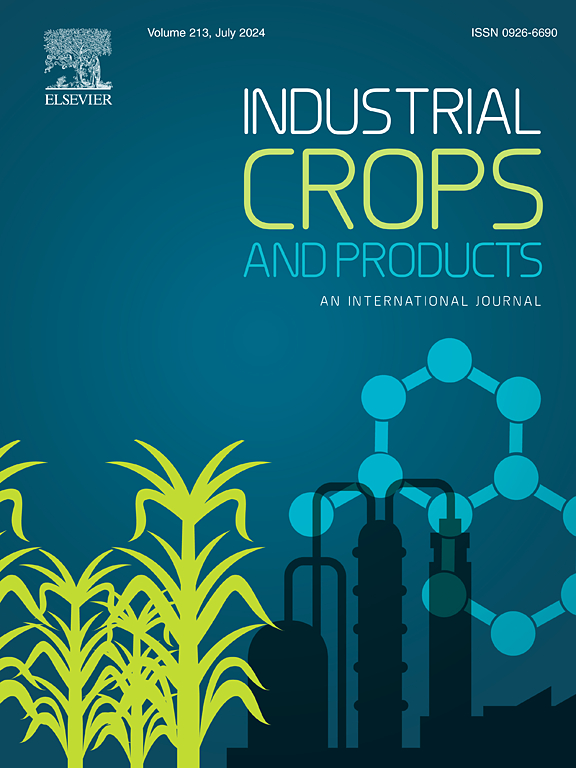R. glutinis As2.703利用多碳源系统生产生物脂、蛋白质和类胡萝卜素
IF 5.6
1区 农林科学
Q1 AGRICULTURAL ENGINEERING
引用次数: 0
摘要
利用农业废物等可再生资源生产能源和化学品是解决能源危机和减轻环境问题的一个重要途径。本研究以玉米芯为原料,利用粘菌As2.703发酵生产生物脂、蛋白质和类胡萝卜素。生物脂可以进一步转化为生物柴油,蛋白质和类胡萝卜素可以作为饲料添加剂。研究了葡萄糖、木糖、乙酸、甘油和不同类型玉米芯水解液等不同底物对R. glutinis As2.703生长和发酵的影响,探讨了多种底物对R. glutinis As2.703产脂、蛋白和类胡萝卜素的影响。结果表明,在多种底物存在下,R. glutinis As2.703的碳代谢模式是先消耗葡萄糖和乙酸,然后是木糖和甘油。以含甘油的纤维素和半纤维素混合水解液为底物,1 kg玉米芯可制得77.44 g脂质、40.76 g蛋白质和20.74 mg类胡萝卜素,高脂质产率路线适合生产生物柴油。以无甘油混合纤维素和半纤维素水解物为底物,每 kg玉米芯可得脂肪31.49 g,蛋白质74.77 g,类胡萝卜素62.98 mg。这种高蛋白含量,加上脂质和类胡萝卜素成分,使其有可能用作饲料添加剂,并且直接利用整个细胞降低了分离成本,使其成为一种更经济的途径。本文章由计算机程序翻译,如有差异,请以英文原文为准。

Production of biolipid, protein, and carotenoid by R. glutinis As2.703 utilizing a multiple-carbon source system
The utilization of renewable resources, such as agricultural waste, for the production of energy and chemicals represents a significant way for the resolution of the energy crisis and the mitigation of environmental concerns. In this study, corncob was used as a raw material for the production of biolipid, protein and carotenoid by fermentation of R. glutinis As2.703. Biolipid can further converted into biodiesel, while protein and carotenoid can be used as feed additives. The effects of different substrates, including glucose, xylose, acetic acid, glycerol, and different types of corncob hydrolysate on the growth and fermentation of R. glutinis As2.703 were investigated to elucidate the production patterns of lipid, protein, and carotenoid under multiple substrates. The results revealed that the carbon metabolism pattern of R. glutinis As2.703 in the presence of multiple substrates was that glucose and acetic acid were consumed first, followed by xylose and glycerol. Using a mixed hydrolysate of cellulose and hemicellulose containing glycerol as the substrate, 77.44 g of lipid, 40.76 g of protein, and 20.74 mg of carotenoid can be obtained from 1 kg of corncob and the high-lipid yield route is suitable for biodiesel production. When the glycerol-free mixed cellulose and hemicellulose hydrolysate was used as the substrate, 31.49 g of lipid, 74.77 g of protein, and 62.98 mg of carotenoid can be obtained from 1 kg of corncob. This high-protein content, coupled with a lipid and carotenoid composition, gives it the potential to be used as a feed additive, and direct utilization of whole cells reduces the cost of isolation and makes it a more economical route.
求助全文
通过发布文献求助,成功后即可免费获取论文全文。
去求助
来源期刊

Industrial Crops and Products
农林科学-农业工程
CiteScore
9.50
自引率
8.50%
发文量
1518
审稿时长
43 days
期刊介绍:
Industrial Crops and Products is an International Journal publishing academic and industrial research on industrial (defined as non-food/non-feed) crops and products. Papers concern both crop-oriented and bio-based materials from crops-oriented research, and should be of interest to an international audience, hypothesis driven, and where comparisons are made statistics performed.
 求助内容:
求助内容: 应助结果提醒方式:
应助结果提醒方式:


